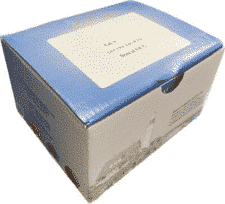Methoprene Test Kit (ELISA Plate)
INTENDED USE
The Methoprene Plate Kit is an immunological laboratory test for quantitative analysis of Methoprene in grains such as barley, corn, oat, rice or wheat.
MATERIALS PROVIDED IN THE PLATE KIT
The kit in its original packaging can be used until the end of the month indicated on the box label when stored at 2 – 8ºC.
1 Frame containing 12 antibody coated test strips of 8 wells each vacuum-packed in aluminized pouch with indicating desiccant.
1 vial each of 0, 0.1, 0.3 and 0.75 ppb Methoprene calibrators
1 vial of Methoprene Enzyme Conjugate.
1 vial containing 14 mL of Substrate.
1 vial containing 14 mL of Stop Solution. (Caution! 1N HCl. Handle with care.)
SKU:
BAS-20-0280
Categories: Crops Protection Chemicals, Food
Description
APPLICATIONS
Methoprene is used in the production of a number of foods, including meat, milk, mushrooms, peanuts, rice, and cereals. It also has several uses on domestic animals (pets) for controlling fleas. It is used in drinking water cisterns to control mosquitoes which spread dengue fever and malaria. Methoprene is commonly used as a mosquito larvicide used to help stop the spread of the West Nile virus.
Methoprene is also used as a food additive in cattle feed to prevent fly breeding in the manure. Regulatory decisions at the state and federal level have also muddied the waters regarding the issue of Methoprene use. While Methoprene is registered for use in all 50 states, two slow-release formulations are presently prohibited from use in fish bearing waters in New York. Maryland places conditions on the use of Methoprene on a case-by-case basis. Furthermore, a number of states have placed limitations on the use of Methoprene (along with dozens of other commonly used pesticides) in waters containing endangered species. Additional confusion has been added due to conflicting information between the federal label provisions for Altosid® use and 1991 EPA Methoprene factsheet3, the factsheet stated that “Methoprene is highly acutely toxic to estuarine invertebrates”, while the label contains no such information. The factsheet was updated in June 2001 to reflect the fact that concerns about toxicity to estuarine invertebrates have been alleviated as a result of the submission of studies which indicate minimal chronic risks.
ASSAY PRINCIPLES
The Methoprene Plate Kit uses polyclonal antibodies that bind both Methoprene and an Methoprene-enzyme conjugate. Methoprene in the sample competes with Methoprene-enzyme conjugate for a limited number of antibody binding sites. Antibodies, which bind Methoprene compounds, are immobilized to the inside of the test wells. In the assay procedure you will:
•Add a sample containing Methoprene to a test well, followed by Methoprene-enzyme conjugate. The conjugate competes with any Methoprene in the sample for the same antibody binding sites.
•Wash away any unbound molecules, after you incubate this mixture for 60 minutes.
•Add clear substrate solution to each well. In the presence of bound Methoprene-enzyme conjugate, the substrate is converted to a blue compound. One enzyme molecule can convert many substrate molecules.
Since the same number of antibody binding sites are available in every well, and each well receives the same number of Methoprene-enzyme conjugate molecules, a sample containing a low concentration of Methoprene allows the antibody to bind many Methoprene-enzyme conjugate molecules. The result is a dark blue solution.
Conversely, a high concentration of Methoprene allows fewer Methoprene-enzyme conjugate molecules to be bound by the antibodies, resulting in a lighter blue solution.
NOTE: Color is inversely proportional to Methoprene concentration.
Darker color = Lower concentration
Lighter color = Higher concentration
Additional information
| Format: |
96-well microtiter plate (12 test strips of 8 wells) |
|---|---|
| Standards: |
0 ,10 ,50 ,250 ppb |
| Incubation Time: |
60 Minutes |
Shipping & Delivery


